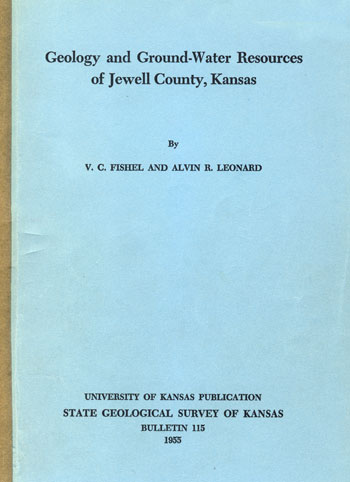Geology and Ground-water Resources of Jewell County, Kansas
By V. C. Fishel and Alvin R. Leonard

Originally published in 1955 as Kansas Geological Survey Bulletin 115. This is, in general, the original text as published. The information has not been updated.
You may also wish to visit our web site on the Jewell County geologic map.
Abstract
This report describes the geography, geology, and ground-water resources of Jewell County in north-central Kansas. The county has an area of 915 square miles and in 1950 had a population of 9,698. Jewell County lies in the Great Plains Pliocene to Cretaceous ground-water province. The county has three types of topography--the deeply dissected uplands in the northern and central parts of the county, a level or gently sloping plain which bounds the uplands on the east and south, and alluvial valleys.
The rocks that crop out at the surface in Jewell County are sedimentary, ranging in age from Late Cretaceous to Recent. The oldest rocks exposed in the county are sandstone and shale beds of the Dakota formation, which crops out in a small area on the south side of Buffalo Creek valley in the southeastern corner of the county. The Dakota is overlain by a conformable series of marine upper Cretaceous rocks classified, in ascending order: Graneros shale, Greenhorn limestone, Carlile shale, and Niobrara formation. Unconsolidated continental deposits of fluviatile and eolian origin represent at least three stages of the Pleistocene. These deposits include the Meade formation of Kansan age, in the northeastern part of the county between Republican River and White Rock Creek. Stream-laid deposits of the Meade formation also fill a narrow valley extending northward from near Mankato. Volcanic ash deposits and associated silt beds in the northwestern and southern parts of the county also are a part of the Meade formation. Later Pleistocene deposits that are present in Jewell County include terrace deposits of Illinoian and Wisconsinan age, the Loveland and Peoria silt members of the Sanborn formation, and Recent alluvium.
Ground-water recharge in the area is largely from local precipitation; ground-water discharge is mainly by seepage into streams and transpiration by plants. All municipal supplies and most domestic and stock supplies are obtained from wells. Most wells in the county are drilled or dug. No irrigation is practiced in Jewell County. On the whole, ground-water supplies are small.
Ground water in Jewell County is generally hard but otherwise suitable for most uses, except for water from certain wells which is excessively high in dissolved solids content or in nitrate.
The field data upon which this report is based are given in tables. They include records of 259 wells, chemical analyses of water from 36 representative wells, and logs of 13 test holes.
Kansas Geological Survey, Geology
Placed on web Nov. 21, 2008; originally published Oct. 1955.
Comments to webadmin@kgs.ku.edu
The URL for this page is http://www.kgs.ku.edu/General/Geology/Jewell/index.html